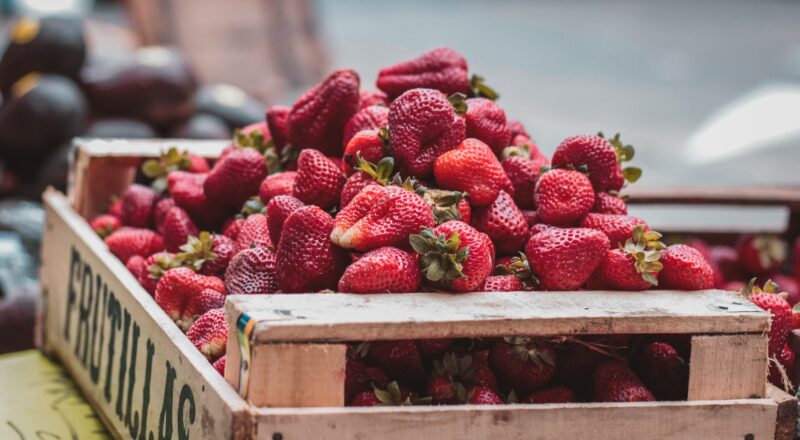Fruits and vegetables have different seasons which means they vary at the time they are best. Here are several fruits and vegetables you should definitely be eating this spring for maximum flavor and amazing health benefits.
1. Apricots
Dried apricots can be found any time of year, however, fresh ones are best in the late spring.
Apricots are high in essential vitamins and minerals but low in calories. They are high in antioxidants, potassium, and are very hydrating. Apricots can help promote eye health, skin health, gut health, and protect your liver.
Fresh apricots can be eaten fresh or added to things like granola, yogurt, jams, and even with slow cooker meat.
2. Artichokes
The main harvest of artichokes takes place in the spring. When choosing an artichoke look for tight, compact leaves and a fresh-cut stem.
Artichokes can have a huge impact on your health. They are high in dietary fiber and protein but have a low amount of calories. Artichokes are a great source of prebiotics and antioxidants which can keep our bodies healthy and clean.
Artichokes are fun to eat from the leaves. They are delicious on their own and also great added to pizza, pasta, chicken dishes, dips, and more.
3. Asparagus
Eating asparagus from March until June will leave you with an amazing flavor and a light crunch.
Asparagus is stocked with nutrients and antioxidants. These powerful ingredients can boost your brain, help your body get rid of excess salts, lower blood sugar, and more!
Asparagus is a unique vegetable that is great in soups, with eggs, roasted in the oven and more.
4. Carrots
True baby carrots, not your typical baby carrots at the store, are best available in spring.
Carrots are high in nutrients with a lot of health benefits. Carrots are a powerhouse of carbs, fiber, vitamins, and minerals. Research shows that carrots can reduce your risk of cancer, lower blood cholesterol, facilitate weight loss, and boost eye health.
Carrots are tasty when eaten raw, glazed with brown sugar, mixed with other vegetables, added to soups, and more.
5. Cherries
Cherries are typically ready to harvest and eat in the late spring.
Nutrients and antioxidants are loaded into the delicious flavor of cherries. Cherries can help relieve insomnia, aid in weight loss, lower hypertension, prevent heart disease, and encourage energy.
Cherries are yummy when fresh and when added to salads, juice, and desserts.
6. Fava Beans
Fava Beans can typically be found in markets in the springtime.
Fava beans might be uncommon but they are a nutrient powerhouse. They are packed with protein, soluble fiber, and lots of vitamins and minerals. They can help prevent Parkinson’s disease, prevent birth defects, boost the immune system, strengthen bones, reduce symptoms of anemia, and more.
Fresh fava beans are great when steamed or added to things like salads, rice, pasta, soups, and more.
7. Fiddlehead Fern
In the early spring, fiddlehead ferns can be found by foraging or at markets.
Fiddlehead ferns are fat-free, cholesterol-free, and sodium-free. They are an excellent way to get vitamin B2, copper, phosphorus, potassium vitamin B3, vitamin C, and manganese.
Fiddleheads should be cooked before eating because they have a small amount of toxins. They are great when steamed, braised, sauteed, or roasted and added to things like pasta or sauces. They are also really good when served with butter or lemon juice.
8. Morels
Morels can be found at markets or by foraging in the spring.
Morels are edible, wild mushrooms with lots of antioxidants, minerals, and vitamins. Morels are high in vitamin D, copper, iron, manganese, and zinc. They help boost the immune system, protect your liver, and more.
These mushrooms are tasty when fried with flour and butter, sauteed with oil and garlic, or added to any of your favorite savory dishes.
9. Mustard Greens
Mustard greens can be found in the early spring, as they grow best when it is cool.
Fat-free, cholesterol-free, and low in sodium, mustard greens are a great addition to your diet. They are a great source of fiber, vitamin A, vitamin C, vitamin K, and folate. Mustard greens can boost immunity, benefit heart health, and promote eye health.
Mustard greens have a peppery flavor that is a great addition to salads, soups, and casserole dishes.
10. Rhubarb
Rhubarb is often one of the first plants available in the spring.
This unique vegetable is low in calories and a good source of fiber and vitamin K1. Rhubarb is a great antioxidant and can help lower cholesterol.
Rhubarb has a tart flavor that is great in jams, desserts, salads, and oatmeal.
11. Strawberries
Strawberries have a peak season that starts in April, they typically come on before other types of berries.
Strawberries are high in vitamin C, folic acid, fiber, and antioxidants. They can prevent heart disease, prevent stroke, decrease inflammation, and lower blood pressure.
These sweet berries are great fresh or added to salads, smoothies, and desserts.
These 11 fruits and vegetables are tasty, healthy, and ready to be eaten this spring. Pick a few each week and add them to your grocery list. You will love the tasty options and the health benefits that come from each of them.
Sources:
thespruceeats.com/fresh-spring-fruits-and-vegetables-2217705
paleoleap.com/10-spring-fruits-vegetables/


Recent Comments